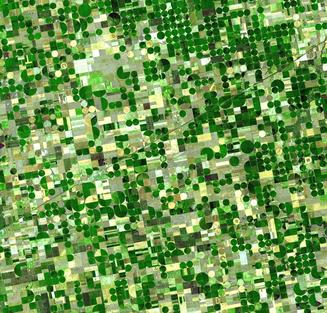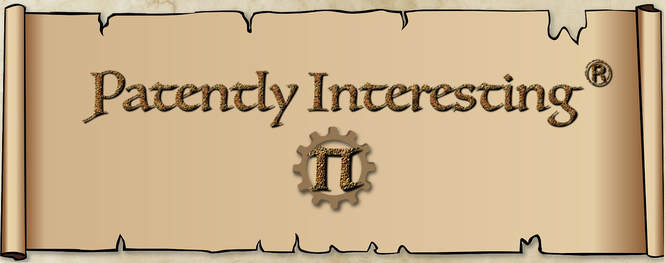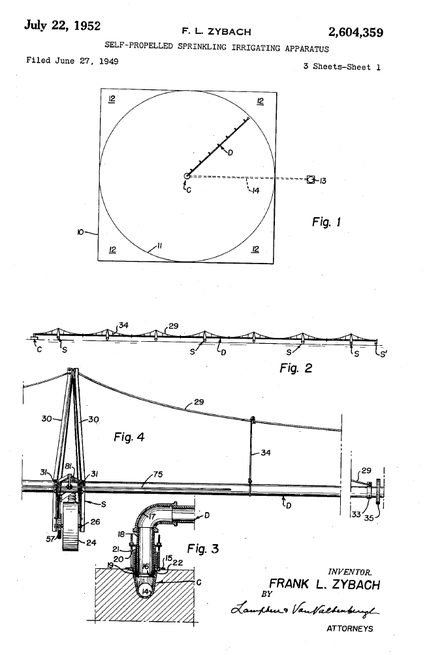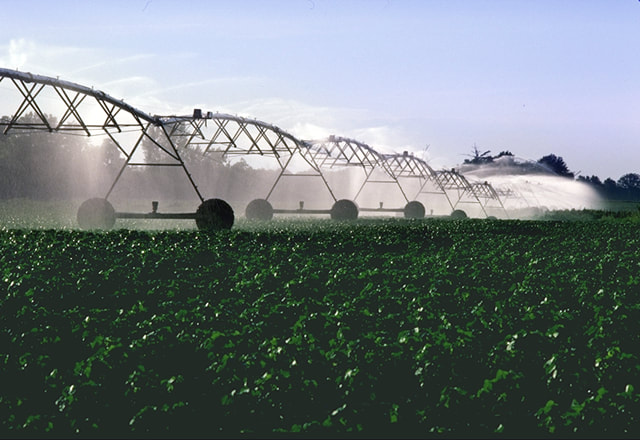 Satellite Picture of Crops in Kansas
Satellite Picture of Crops in Kansas
On July 22 of the year 1952, U.S. Patent No.: 2,604,359 issued to Frank Zybach for "Self-Propelled Sprinkling Irrigating Apparatus". The invention of the '359 patent revolutionized agriculture throughout the world by introducing center pivot irrigation, which is a form of irrigation in which equipment rotates around a pivot to spray water on crops. A circular area centered on the pivot is irrigated with water, thereby creating a geen circle (of crops) when viewed from above. The satellite picture to the left shows how center pivot irrigation has transformed the landscape of America's heartland.
In 1976, Scientific American proferred that center pivot irrigation was "perhaps the most significant mechanical innovation in agriculture since the replacement of draft animals by the tractor." That's an impressive accolade for an invention made by a man with less than an eighth-grade education.
Frank Zybach was born on July 10, 1894 in Lafayette, Oregon to parents of Swiss lineage, who had moved to Oregon from Nebraska in search of work. When Zybach was just 3-months old, the family retuned to Nebraska, where Zybach's father opened a blacksmith shop and operated a farm. In the seventh grade, Zybach quit school to work on the farm and in the blacksmith shop. From a very early age, Zybach displayed mechanical aptitude and a proclivity for inventing. When he was only thirteen, Zybach made his first invention: a cart with a seat and two swivel wheels that could be attached to a harrow for breaking up soil. Other inventions would follow, including an automatic transmission for an automobile, an automatic tractor guide and a walking doll. None of Zybach' inventions met with much commercial success until his sprinkling apparatus.
At some point, Zybach moved to Strasburg, Colorado, where his brother and brother-in-law lived. The area was dry and received very little rain. Nonetheless, Zybach became a tenant wheat farmer in Strasburg. In 1947, Zybach and a neighbor attended an irrigation field day in Prospect Vally, Colorado, where they witnessed a conventional sprinkler system being used to irrigate a large field. The sprinkler system would be assembled and operated in one part of the field, then would be disassembled and moved to another part of the field, where it was reassembled and operated. This process would continue until the entire field was watered. The work involved in assembling, breaking down and re-assembling the sprinkler system was dirty and difficult.
After witnessing the sprinkler system at Prospect Valley, Zybach knew there had to be a better way to irrigate a large field. And there was. By 1948, Zybach had built a prototype center pivot sprinkler system and in June of 1949, Zybach filed the application for the '359 patent. The center pivot sprinkler system of the '359 patent included a long distributing pipe mounted on a plurality of wheeled supports, each of which included a tower and a pair of rearwardly and outwardly-directed water discharge spouts. The supports were spaced-apart about 200 feet and were interconnected by suspension cables extending between the towers. In the patent, eight supports are shown, so the distributing pipe was about 1600 feet long.
The distributing pipe was connected to a central pipe located in the center of a field to be watered. The central pipe was fed water from a well using natural pressure or a buried pump. The water from the central pipe traveled through the distributing pipe to the supports, where the water was sprayed from the discharge spouts onto the field. The water at the supports also actuated drives that rotated the wheels of the supports, causing the distributing pipe to rotate about the central pipe in a large circle, spraying water over the field.
In Zybach's prototype sprinkler system, the distributing pipe was elevated only a couple of feet and, thus, could only be used on shorter crops, like sugar beets, alfalfa and melons. Zybach, however, raised the distributing pipe in later models to accommodate taller crops, such as corn. In the '359 patent, the distributing pipe is disclosed as being elevated from 2 to 6 feet.
Zybach formed a partnership with A.E. Trowbridge to manufacture and sell Zybach's sprinkler system. However, after several years of mediocre sales, Zybach and Trowbridge licensed the '359 patent to Robert Daugherty, who owned the Valley Manufacturing Company (later Valmont Industries) in Valley, Nebraska. Over the years, Valley Manufacturing made a number of improvements to Zybach's sprinkler system, including raising the distributing pipe for tall crops, installing water guns at the end of the distributing pipe to reach corners between crop circles and using electric motors to move the supports rather than water-powered drives.
In 1976, Scientific American proferred that center pivot irrigation was "perhaps the most significant mechanical innovation in agriculture since the replacement of draft animals by the tractor." That's an impressive accolade for an invention made by a man with less than an eighth-grade education.
Frank Zybach was born on July 10, 1894 in Lafayette, Oregon to parents of Swiss lineage, who had moved to Oregon from Nebraska in search of work. When Zybach was just 3-months old, the family retuned to Nebraska, where Zybach's father opened a blacksmith shop and operated a farm. In the seventh grade, Zybach quit school to work on the farm and in the blacksmith shop. From a very early age, Zybach displayed mechanical aptitude and a proclivity for inventing. When he was only thirteen, Zybach made his first invention: a cart with a seat and two swivel wheels that could be attached to a harrow for breaking up soil. Other inventions would follow, including an automatic transmission for an automobile, an automatic tractor guide and a walking doll. None of Zybach' inventions met with much commercial success until his sprinkling apparatus.
At some point, Zybach moved to Strasburg, Colorado, where his brother and brother-in-law lived. The area was dry and received very little rain. Nonetheless, Zybach became a tenant wheat farmer in Strasburg. In 1947, Zybach and a neighbor attended an irrigation field day in Prospect Vally, Colorado, where they witnessed a conventional sprinkler system being used to irrigate a large field. The sprinkler system would be assembled and operated in one part of the field, then would be disassembled and moved to another part of the field, where it was reassembled and operated. This process would continue until the entire field was watered. The work involved in assembling, breaking down and re-assembling the sprinkler system was dirty and difficult.
After witnessing the sprinkler system at Prospect Valley, Zybach knew there had to be a better way to irrigate a large field. And there was. By 1948, Zybach had built a prototype center pivot sprinkler system and in June of 1949, Zybach filed the application for the '359 patent. The center pivot sprinkler system of the '359 patent included a long distributing pipe mounted on a plurality of wheeled supports, each of which included a tower and a pair of rearwardly and outwardly-directed water discharge spouts. The supports were spaced-apart about 200 feet and were interconnected by suspension cables extending between the towers. In the patent, eight supports are shown, so the distributing pipe was about 1600 feet long.
The distributing pipe was connected to a central pipe located in the center of a field to be watered. The central pipe was fed water from a well using natural pressure or a buried pump. The water from the central pipe traveled through the distributing pipe to the supports, where the water was sprayed from the discharge spouts onto the field. The water at the supports also actuated drives that rotated the wheels of the supports, causing the distributing pipe to rotate about the central pipe in a large circle, spraying water over the field.
In Zybach's prototype sprinkler system, the distributing pipe was elevated only a couple of feet and, thus, could only be used on shorter crops, like sugar beets, alfalfa and melons. Zybach, however, raised the distributing pipe in later models to accommodate taller crops, such as corn. In the '359 patent, the distributing pipe is disclosed as being elevated from 2 to 6 feet.
Zybach formed a partnership with A.E. Trowbridge to manufacture and sell Zybach's sprinkler system. However, after several years of mediocre sales, Zybach and Trowbridge licensed the '359 patent to Robert Daugherty, who owned the Valley Manufacturing Company (later Valmont Industries) in Valley, Nebraska. Over the years, Valley Manufacturing made a number of improvements to Zybach's sprinkler system, including raising the distributing pipe for tall crops, installing water guns at the end of the distributing pipe to reach corners between crop circles and using electric motors to move the supports rather than water-powered drives.



